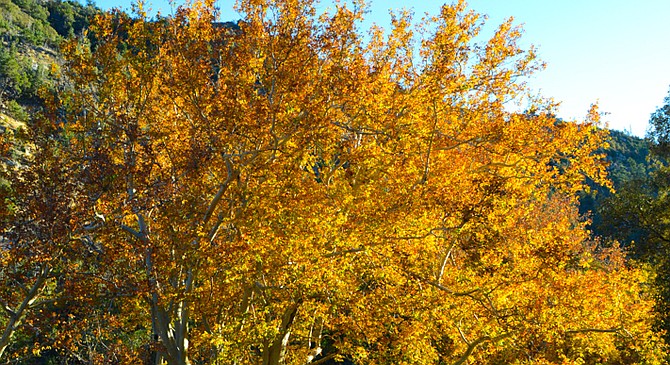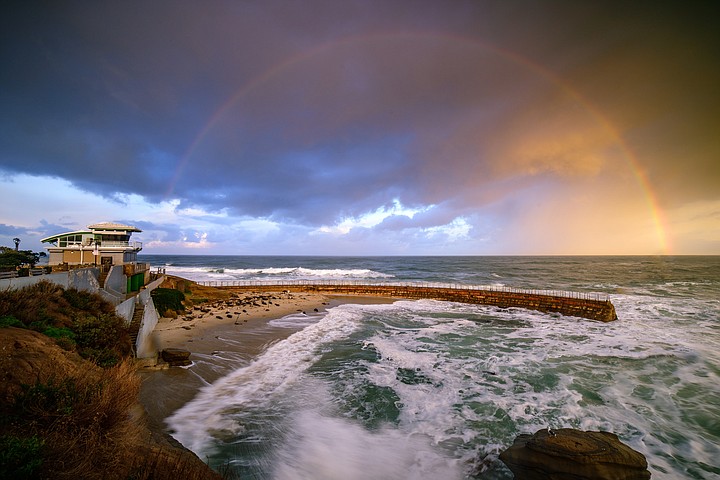 Facebook
Facebook
 X
X
 Instagram
Instagram
 TikTok
TikTok
 Youtube
Youtube

Liquidambar Trees, or sweet gums, the deciduous trees gracing front yards, parks, and campuses throughout the San Diego area, have been putting on an exceptionally colorful show. The leaves of some varieties turn to purple or red; the leaves of other varieties fade to golden yellow. Still other varieties hold on to their green leaves until sometime in December. Most liquidambars in our area regain their light green foliage by late February
Sycamores, found in San Diego’s coastal and foothill canyons as well as in suburban and park landscaping, stand at their autumnal best this time of year. Stroll beneath their crispy, rustling canopies and catch the sunbeams scattering among their mottled trunks and yellowbrown leaves. Some of San Diego’s biggest native sycamores reside in Lopez Canyon, a part of Los Peñasquitos Canyon Preserve near Sorrento Valley. Hundreds of sycamores can also be seen in Marian Bear Park (San Clemente Canyon) along Freeway 52 between University City and Clairemont.

“Rainbow Season” arrives with the first rains of late fall. Scattered showers are best for rainbow watching: sunlight refracting and reflecting through the raindrops causes two bows to appear: an intense circular arc at 42˚, and a bigger, but weaker arc at 51˚ from the antisolar point (the point in the sky diametrically opposed to the sun’s position). From November through mid-February, the sun never gets higher than 42˚ above the horizon as seen from San Diego, so (rain and sunlight permitting) the brighter of the two arcs may appear above the horizon at any time of day. In spring and summer, rainbows are never seen in the sky around midday because the sun is too high — and the antisolar point is too low.
The above comes from the Outdoors listings in the Reader compiled by Jerry Schad, author of Afoot & Afield in San Diego County. Schad died in 2011. Planet information from SkyandTelescope.org.


Liquidambar Trees, or sweet gums, the deciduous trees gracing front yards, parks, and campuses throughout the San Diego area, have been putting on an exceptionally colorful show. The leaves of some varieties turn to purple or red; the leaves of other varieties fade to golden yellow. Still other varieties hold on to their green leaves until sometime in December. Most liquidambars in our area regain their light green foliage by late February
Sycamores, found in San Diego’s coastal and foothill canyons as well as in suburban and park landscaping, stand at their autumnal best this time of year. Stroll beneath their crispy, rustling canopies and catch the sunbeams scattering among their mottled trunks and yellowbrown leaves. Some of San Diego’s biggest native sycamores reside in Lopez Canyon, a part of Los Peñasquitos Canyon Preserve near Sorrento Valley. Hundreds of sycamores can also be seen in Marian Bear Park (San Clemente Canyon) along Freeway 52 between University City and Clairemont.

“Rainbow Season” arrives with the first rains of late fall. Scattered showers are best for rainbow watching: sunlight refracting and reflecting through the raindrops causes two bows to appear: an intense circular arc at 42˚, and a bigger, but weaker arc at 51˚ from the antisolar point (the point in the sky diametrically opposed to the sun’s position). From November through mid-February, the sun never gets higher than 42˚ above the horizon as seen from San Diego, so (rain and sunlight permitting) the brighter of the two arcs may appear above the horizon at any time of day. In spring and summer, rainbows are never seen in the sky around midday because the sun is too high — and the antisolar point is too low.
The above comes from the Outdoors listings in the Reader compiled by Jerry Schad, author of Afoot & Afield in San Diego County. Schad died in 2011. Planet information from SkyandTelescope.org.
Comments